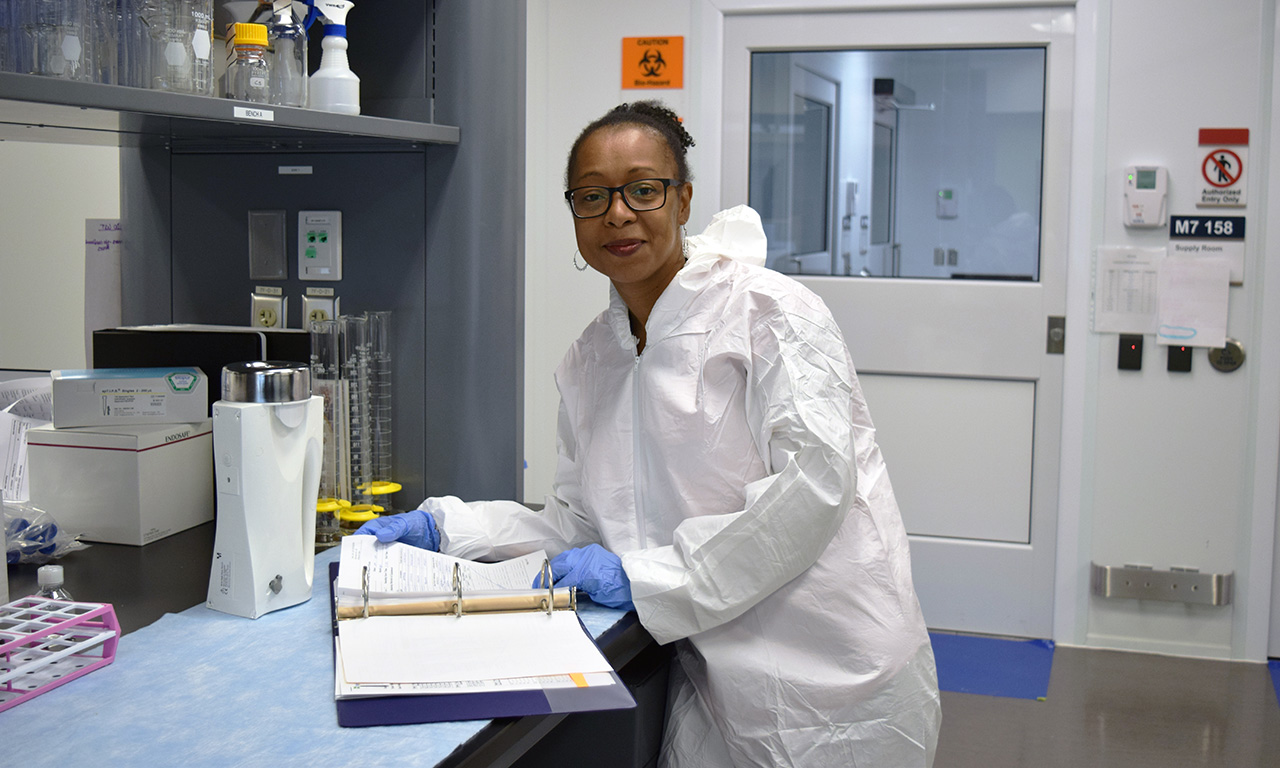Behind the scenes with Dr. Nickett Donaldson-Kabwe
Bio basics: Operations manager of the Good Manufacturing Practices (GMP) Facility at Sunnybrook Research Institute (SRI). Previously worked as a research associate at McMaster University. Completed her PhD in cell and molecular biology, a certification as a clinical research associate at McMaster University and an undergraduate degree in biotechnology at Brock University. Born in Jamaica and immigrated to Canada two days after her 12th birthday. Resides in Mississauga, Ont. with her husband and two children. Joined SRI in April 2014.
What drew you to work at SRI?
My grandmother was diagnosed with breast cancer a few years ago and she received treatment at the Odette Cancer Centre. That’s how I was first exposed to Sunnybrook. Then I saw the [job posting] and thought [it would be a] great place to work, and I applied.
What is the GMP facility?
It is a Health Canada-regulated facility producing new cell and gene therapy products for use in human clinical trials. The facility is equipped with four Grade B and C cleanrooms used to process and manufacture these products. These controlled cleanrooms have very low levels of environmental contaminants like lint, dust, aerosol particles and airborne microbes, because strict cleanroom practices are in place. The volume of air in each of our cleanrooms is exchanged over 260 times per hour, making the room air at minimum 1,000 times cleaner than outside air. The facility employs strict practices to deliver quality across all facets of its operations.
What does the facility enable researchers to do?
The facility was built to enable researchers at SRI, and in Toronto and surrounding areas to be at the nexus of regenerative medicine. This branch of translational medicine deals with replacing, regenerating and engineering human organs, tissues and cells. It provides researchers with infrastructure, equipment and GMP expertise to take advanced bench research projects from the lab and into the clinics. A facility of this calibre will allow safe production of cellular products, biologics and biological drugs for testing in clinical trials and use in clinical settings.
What are some of your responsibilities?
I develop most of the protocols, write a lot of SOPs [standard operating procedures] and review projects. We make sure the cleanrooms are certified and are fit for clinical projects. Some of my responsibilities include pricing out services, writing service contracts, organizing operational logistics and creating the facility operating budgets. I also meet with the clients to determine their needs, assess our capabilities to deliver these and price out whatever services they need. It’s a busy place. We make sure that it’s always certified and ready to go.
What’s a typical day like?
It changes every day. We are constantly documenting all activities, checking the cleaning logs to make sure the room gets cleaned, performing environmental monitoring and updating practices. We make sure all the required documents are available and signed off prior to filing.
What’s the most rewarding part of your job?
Getting the products out of the lab and into the clinics—that’s the whole objective of the GMP facility.
What are some of the products that come out of the labs and into the clinics?
The facility is accessible to internal and external academics as well as industry projects. Current projects include isolating and culturing islet cells from the pancreas to treat diabetes; aseptic expansion of T cells; and viral transduction of T cells for treating a genetic disorder. Dr. Charles Cunningham, a senior scientist in Physical Sciences, is producing a hyperpolarized compound to detect early-stage heart failure and understand if metastatic cancers are responding to therapy. The facility is also preparing to use isolated autologous stem cells to treat burn patients.
Was there a learning curve when you started?
I took the facility from the ground up to the operation stage. We are a lot further [ahead] than where we were three years ago. When I started my job, there were no procedures or systems in place to start operating. We had to go through the validation phase, ensuring all critical equipment and utilities were qualified as per Health Canada specifications required to get the GMP facility up and running.
Is it common for hospital-based research institutes to have GMP facilities?
There is an increased need for these facilities and we are seeing a few of them coming up. In the U.S., they have quite a number of them in a lot of hospitals and research institutions. I think it’s because manufacturing stem cell and regenerative medicine products warrant such infrastructures. We need to have facilities like this to be able to do the cell therapy.
Are you fully operational right now?
We are fully operational. We had our quality matrix survey done, and we are 80% there in terms of quality and what we can offer our clients.
Do you have any hobbies or interests you enjoy outside of work?
I like to read a lot of different novels. A good thing about my commute is that I’m able to read and get certain aspects of work done on the TTC and GO Transit. I spend a lot of my time with my kids because they are young and involved in activities.
Why did you choose a career in science?
I love experimenting, and I’ve always been drawn to anything scientific, the unknown, basically, just finding out how something works. Biological systems have always fascinated me. I’ve seen myself in a lab coat ever since I was a little girl.
Did you ever think you would manage a GMP facility?
No, I had never thought about it. For me, I always thought I’d be in research and probably teaching. I never really thought I would be behind the desk working in an operational role. But I do enjoy the numerous aspects of what I’m doing and being in a constant state of learning.
The GMP facility is part of the Centre for Research in Image-Guided Therapeutics, funded by the Canada Foundation for Innovation.






